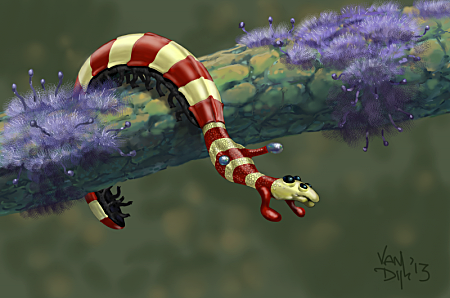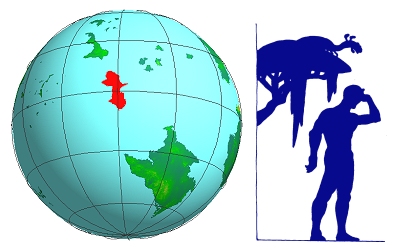
|
The famous writer/carnivorist Felsacker provided some lively comments regarding the grouillard (reprinted from 'Paleo Days', with permission):
"Beware of grouillard spit! A undergrad student, Evanita Försterin, found that a grouillard had entered her shelter while she was away. She was foolish enough to try to frighten it out by shouting and waving at it. She shouldn't have done that; just wait and it will come out in its own good time. The cornered grouillard was confused and agitated. After scampering about in the tent for a while it suddenly froze, straightened its neck, pursed its lips (well, not really lips, but there's no better word) and spat. Oh, it spat all right! Three of four gobs of greenish spittle hit Evanita's head and chest. The first second or so she just stood there, stupefied, while the grouillard remained frozen. Then the stench hit her, and she just doubled over and became violently sick. The grouillard took the opportunity to rush out of the tent, cackling to itself. The spit proved to be extremely nasty stuff, for poor Evanita reeked for an entire week, in spite of repeated washing and generous splashes of perfumes and deodorants.
The male students avoided her for a week, too. Poor Evanita; several rejections in one week."
|
|
Here is a closely related species E. admonitionis; note how its sensory stalks are attached to what observers with an eye trained to judge Terran animals would call the neck. The independent movements of the various stalks are somewhat disconcerting if seen from the corner of your eye.
Blog post on another grouillard (February 2013)
As you can see, it has a banded colour pattern that just screams 'Here I am!' to any animal with a decent vision. Remember that the grouillard you are familiar with (Oructator olidus) is black and brightly red, so it is not exactly given to camouflage either. These warning colours, because that is what they are, tell other animals not to fool around with a grouillard: except for its extremely nauseating and somewhat toxic spit, the animals taste extraordinarily awful. Young predators may bite into a grouillard once, and that grouillard will not live to tell about the experience. But the predator will, and will not bother other grouillards for a long time, if ever.
|

|




